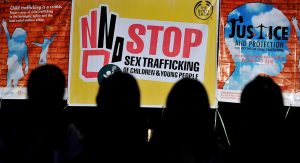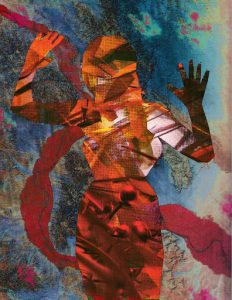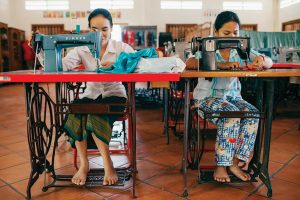By Tamia Smith

Imagine this: being taken away from what you knew as your life and being thrown into a world of sex, violence and danger. That is a summation what sex trafficking is.
The journalist Ashton Kobler documented the story of Umida, a Russian woman, who was accepted work promised in Thailand by a random woman because her family was impoverished. She thought she would be able to help support them. Unfortunately, Umida was brought to Thailand and her documents, except her passport, where immediately destroyed. The woman did not give her food or money, nor did she allow Umida to go out, unless it was for “work.” Umida was forced to be a prostitute on the Bangkok streets.
Sex trafficking happens right before our eyes, in plain sight, and yet we often do not see it at all. Thailand, an important southeast Asian country, has a large sex trafficking rate. Over 500 women and children, natives and foreigners, are being trafficked within the country. However, these numbers are likely to be under-reported and have increased in more current years. Their problems may not seem relevant to those of us living in the United States, but out actions are directly involved in perpetuating circumstances that cause these women to be enslaved. Sex trafficking is a major issue in Thailand because of two reasons: foreign demand of sex and local poverty fueled by global labor inequities. Thailand’s sex industry has grown because rural, poor young girls and women are seeking ways to support their families, or they are used as repayment for debts and because foreigners travel to the country seeking, illegal sex. Organized tours, normally involving foreign men, many of whom want younger women are a reason why many women and young girls are sold through the sex industry daily in the country. And it has to stop. The Thai government has enacted some laws and guidelines to eliminate the heinous crime, but these laws alone are not enough.
Back to Umida and her story, she tried to escape and was almost successful. One of her customers had given her enough money to buy a plane ticket home, and some extra to help take care of her son. Umida rushed to the Uzbek consulate and was issued a certificate to return to Russia. At the airport, Umida was approached by a veiled woman, who revealed herself to be Umida’s trafficker. Umida feared her, and her certificate to return home was snatched away. Umida had to go back to prostitution. She worked for half a year without any money, while living in an apartment with no shower or food. She could only eat when a client took her out.
Sex trafficking doesn’t only do mental damage, but physical damage as well. The women and children involved in sex trafficking experience harrowing traumas while being trafficked. This trauma involves emotional and verbal abuse, like name calling and yelling; physical abuse, like beatings, starvation and rape – which victims do not even consider rape. To add to this trauma, a lot of young girls and women have contracted HIV or AIDS due to trafficking. This is due to the lack of public health interventions set in place by the Thai government.
I know you’re probably thinking what can one person do? Cambodian activist, Somaly Mam, wrote The Road of Lost Innocence about her own experiences being sold into sex slavery as a child in neighboring Cambodia. She reports on the harrowing abuses she experienced and the efforts she went through to get out of that life. Since that time, she has dedicated her life to rescue and help rehabilitate other victims of sex trafficking. Her foundation has established four safe houses for girls, provided them with occupational training and conducted countless educational programs for rural men and women on the dangers of trafficking. I know majority of us have never experienced sex trafficking, but that doesn’t mean that we cannot step forward to make sure that those who have won’t experience it again. We can also take this stand to make sure that no other woman or child will have to experience this inhumane crime.
Sex traffickers go above and beyond to hide their actions. But there are signs of sex trafficking that you can be aware of. For instance, signs of physical abuse or injury; individuals who are always accompanied by someone else who speaks for them; persons who appear to be afraid or controlled by those around them; and individuals who are travelling with minimal belongs (no luggage, no identification/passports – or aren’t able to carry their own identification/passports). Those are just a few signs. Click here to read about more signs of sex trafficking.
To Thai citizens, take a stand against sex trafficking, in Thailand. Contact your government officials. Tell them that there should be more laws enacted to prevent sex trafficking and to punish traffickers. If you see something suspicious, contact the police. There are ways to help slow down, and even prevent, sex trafficking. And one small step from you can help to eventually eliminate sex trafficking, even globally.
Umida once again gained an opportunity for escape. Emily Chalke, the co-founder of Ella’s Home, a nonprofit that helps women exit trafficking and exploitation was working with Nightlight International in Thailand to help fight against sex trafficking at the time. Chalke met Umida in a Bangkok hotel, notorious for exchanges between sex workers and their clients, after she was informed by another Uzbek women that Umida’s passport had been taken. She recalls that everyone at the hotel knew Umida as “the girl who was in trouble.” After Umida told Chalke that she wanted to escape, the two agreed to meet at another hotel, where Umida would pretend she was seeing a client. From there, they took a taxi to a safe house. Chalke recalls that Umida was angry when they first met because so much had been taken away from her, she only had the clothes on her back and a small notebook, noting all of the amounts paid to her trafficker, over $10,000. Chalke and Nightlight International arranged for Umida to receive a new passport; they also purchased her a plane ticket and Umida was able to return home. Her case was reported to the police and her trafficker was located and arrested.
I know it may be hard to break the cycle of trafficking in Thailand, as an American, but you can do it as well. Chalke was not a Thai citizen, but she made efforts to save and protect victims of trafficking in Thailand. We Americans can join NGO’s like Chalke’s, or we can start our own. We have to push to stop sex tourism, we can educate American sex tourists on the “dark side” of the industry – the things they do not get to see. We have to educate them on the traumas trafficking victims experience. To make further efforts, we can publicize and boycott travel agencies that organize sex tours for Americans to Thailand and other places. We have to research and find ways to encourage education to Thai women and girls, so that they can have better financial opportunities.
Click here to read about NGO’s focused on sex trafficking among women and girls in Thailand.
Tamia Smith is a senior undergraduate at East Carolina University, majoring in biological anthropology and organic and biomolecular chemistry. She hopes to graduate in May 2020. She plans to pursue master and doctoral degrees in Criminal Justice. Her career goals are to work as a forensic anthropologist and medical examiner for the Federal Bureau of Investigation (FBI) in Quantico, Virginia and as to work as a member of the U.S. Department of Defense. In achieving these goals, Tamia hopes to provide progress for her people and the safety of this nation.

 justice system. There are protocols put in place for obligatory purposes, but they are contradictory at best and have a lot of grey area. The United Nations Protocol on Human Trafficking defines trafficking as:
justice system. There are protocols put in place for obligatory purposes, but they are contradictory at best and have a lot of grey area. The United Nations Protocol on Human Trafficking defines trafficking as:

